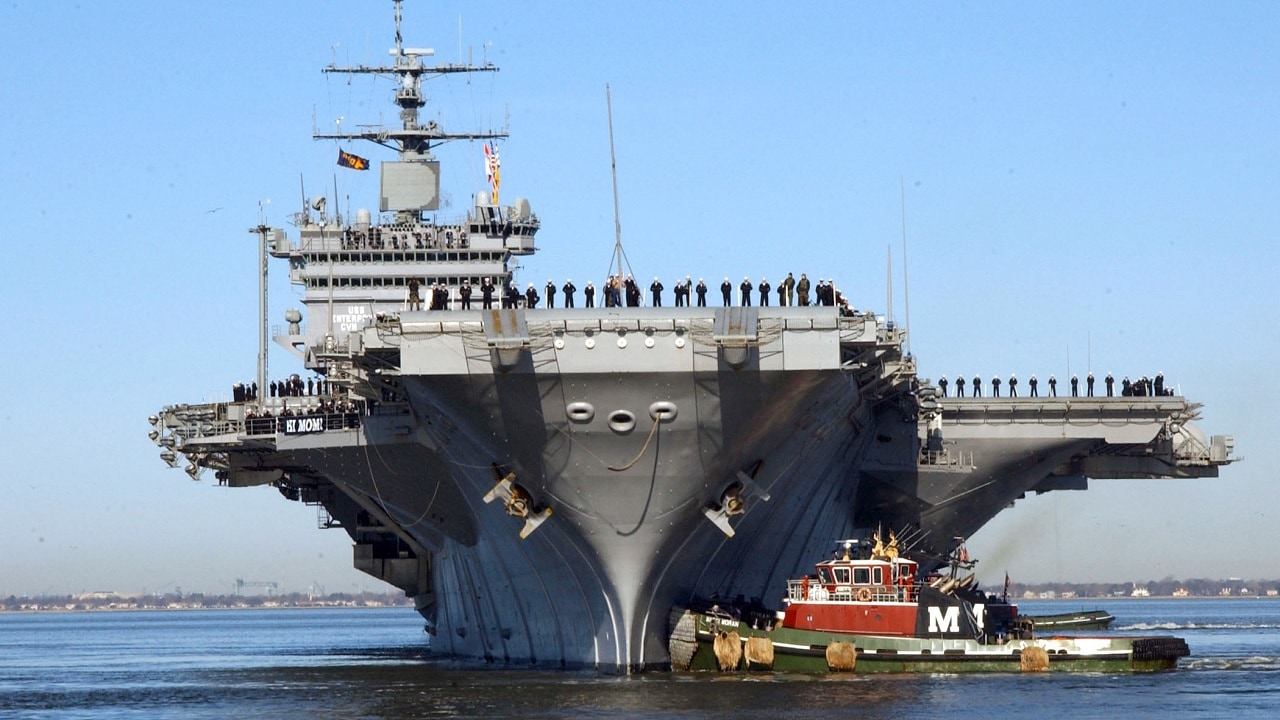The United States Navy’s first nuclear-powered aircraft carrier USS Enterprise (CVN-65) was retired from service in 2012. More than a decade later, there is finally a plan coming into focus on how the ship will be dismantled, and it could help the service be better prepared as other nuclear-powered supercarriers reach the end of their respective lives.
Breaking up is hard to do, especially when it involves a nuclear-powered warship. As the largest vessels in service, the issue is that much greater with aircraft carriers.
It was announced this week that the former CVN 65 will be dismantled and disposed of using commercial industry at one of three possible locations, including Newport News, Virginia; Brownsville, Texas; or Mobile, Alabama. The U.S. Navy said that the commercial companies would be responsible for dismantling the warship’s defueled reactor plants, as well as disposing of the reactor plant components through several hundred shipments to authorized waste disposal sites.
Alternative 3 Going Forward
This current plan is actually the Navy’s “Alternative 3” and follows two other alternatives that could have sent the nuclear-powered vessel to Puget Sound Naval Shipyard in Bremerton, Washington.
Alternative 1 called for the partial dismantlement and removal of non-radiological portions of ex-Enterprise at a commercial dismantlement facility. The remainder, including the defueled reactor plants, would have then been transported by heavy-lift ship to Puget Sound Naval Shipyard & Intermediate Maintenance Facility for recycling, construction of eight single reactor compartment packages, and shipment by barge to the Port of Benton near the Department of Energy (DOE) Hanford Site, and via a multiple-wheel, high-capacity transporter to the DOE Hanford Site for disposal.
Alternative 2 was essentially the same but called for four dual reactor compartment packages to be constructed rather than eight single reactor compartment packages. Those packages would have been heavier and larger than reactor compartment packages currently transported to the Department of Energy (DOE) Hanford Site under the existing Navy program.
A “No Action Alternative” was considered for the waterborne storage of the retired flattop and periodic maintenance to ensure that storage continues in a safe and environmentally responsible manner.
“[Alternative 3] will allow the Navy to reduce the Navy inactive ship inventory, eliminate costs associated with maintaining the ship in a safe stowage condition, and dispose of legacy radiological and hazardous wastes in an environmentally responsible manner while meeting the operational needs of the Navy,” the Puget Sound Naval Shipyard & Intermediate Maintenance Facility said in a news release.
The Final Days of CVN-65, Aircraft Carrier USS Enterprise
USS Enterprise was officially decommissioned back in 2017 and it presently sits at a pier at the Newport News Shipbuilding. That could give the facility an edge as it won’t require moving the retired carrier again. However, International Shipbreaking Limited of Brownsville is currently scrapping the former USS Kitty Hawk (CV-63) and USS John F. Kennedy (CV-67).
Those conventionally-powered aircraft carriers were sold to the facility for just one penny each – but the Navy will have to pay a considerable sum to have the former USS Enterprise disposed of safely.
As of last year, it was estimated that dismantling the carrier could take at least five years and cost between $554 and $696 million at a commercial yard. Another plan called for the dismantling to take upwards of 15 years and cost as much as $1.358 billion.
One issue is that U.S. Navy shipyards are overworked, and can’t adequately address the maintenance for active warships – and there simply isn’t the capacity to take old nuclear-powered carriers apart.
The Legacy of the USS Enterprise
Known as “The Big E,” CVN 65 was the eighth vessel to bear the name Enterprise. Commissioned at Newport News, Virginia on November 25, 1961, USS Enterprise (CVN-65) became the first nuclear-powered aircraft carrier to enter service. Along with USS Bainbridge (DLGN-25) and USS Long Beach (CGN-9), she was part of the nuclear task force, Operation Sea Orbit, from May to October 1964, circumnavigating the globe without refueling.
The flattop first took part in combat operations in Vietnam, and late in her career was used in the Iraq War. At the time of her inactivation, Enterprise was the third-oldest commissioned vessel in the U.S. Navy after the wooden-hulled USS Constitution and the USS Pueblo (AGER-2).
Her name will live on as the third Gerald R. Ford-class supercarrier – the future CVN-80 that is now under construction at the Newport News Shipbuilding – will be the next warship to be named Enterprise.
Author Experience and Expertise
A Senior Editor for 19FortyFive, Peter Suciu is a Michigan-based writer. He has contributed to more than four dozen magazines, newspapers, and websites with over 3,200 published pieces over a twenty-year career in journalism. He regularly writes about military hardware, firearms history, cybersecurity, politics, and international affairs. Peter is also a Contributing Writer for Forbes and Clearance Jobs. You can follow him on Twitter: @PeterSuciu.
From the Vault
‘He Should Quit’: Donald Trump Just Got Hit With A Devastating New Poll

